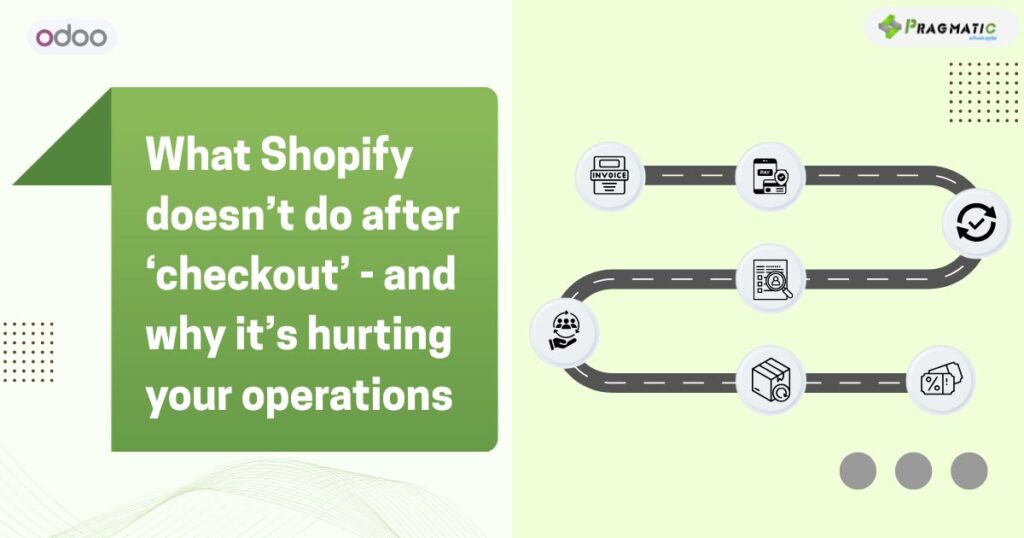

It’s Friday afternoon and your flash sale was a success. Hundreds of orders are in. But instead of celebrating, your team scrambles :
👉Someone in finance is creating invoices manually for dozens of unpaid orders.
👉Ops is trying to figure out which payments have cleared.
👉Your warehouse team marks some orders as fulfilled in Shopify, but the support team doesn’t see those updates in your ERP.
👉Customers who used a discount are showing up in the books as having paid full price.
That invisible 30–60 minutes after checkout is where operational chaos starts.
And when you’re processing dozens or hundreds of orders a day, it adds up to hours of delay, frustration and lost accuracy.
These numbers show that manual backend management isn’t just annoying – it’s expensive.
Shopify lets customers place unpaid orders (for example, if they select a bank transfer or manual payment method).
But unless you manually create a draft invoice in your backend system, finance won’t have a way to track what’s due.
With automated draft invoice generation, unpaid orders trigger an invoice in Odoo instantly. That means your finance team doesn’t need to chase details – they open their dashboard, and it’s all there.
Let’s say a customer pays via UPI or PayPal on Shopify.
Your ops or finance teams want to know – Was it successful? Was it partial? How did they pay?
Without sync, you’re toggling between tabs and cross-referencing. With real-time sync, the payment method and status show up directly in Odoo : Paid, Unpaid or Partially Paid.
Your teams know exactly what’s cleared – no Slack pings or manual checks.
Fulfillment data often lives only in Shopify. But what happens when your ERP or operations team needs to coordinate logistics?
Whether an order is Fulfilled, On Hold or Restocked, this sync ensures those statuses are reflected in your backend. That means fewer “Where’s my order?” queries and a smoother support experience.
Duplicate records and overwritten customer data can tank your CRM. Shopify sends full customer details with each order – but if you’re not careful, syncing can overwrite existing notes or history.
This connector smartly enriches existing customer records without wiping anything. It protects your relationship context while still keeping data current.
Every first-time buyer in Shopify deserves to be captured properly. Without automation, it’s easy to lose track of these new contacts, especially if you rely on manual CSV uploads.
With this feature, new customers are automatically created in Odoo, complete with email, phone and addresses – ready for email marketing, remarketing and more.
You apply tags like “VIP”, “Gift” or “Express” in Shopify for a reason. If your ERP doesn’t see them, that intent gets lost.
With this sync :
This one’s big : if a customer applies a 20% discount at checkout, but your ERP logs full price, you’re misreporting revenue.
Discount codes and amounts now sync directly. That keeps your invoicing accurate and gives marketing visibility into promo performance.
Let’s bring this to life with two real-world scenarios that show the contrast between manual operations and real-time sync:
Brand A
Growing Fast, Falling Behind
A premium lifestyle store saw a spike in traffic after a successful influencer campaign. Orders poured in – great news, until ops had to catch up :
By the end of the week, customer satisfaction dipped, finance needed overtime and marketing couldn’t measure the real impact of the promo.
Brand B
Synced and Scaling Smoothly
This team had already plugged in the Shopify Odoo Connector. When their sale went live –
The difference? Same volume of orders, but zero chaos.
Their backend was as ready to scale as their storefront.
Shopify helps you sell. But it’s what happens after checkout that defines your customer experience and your team’s sanity.
The truth is, most brands don’t need more apps – they need fewer gaps.
With Shopify Odoo Connector, you –
👉Automate critical back-office steps
👉Maintain accuracy across systems
👉Get your team working with the same clean, synced data
👉Clean data. Confident teams. Faster ops.
Shopify helps you sell. But it’s what happens after checkout that defines your customer experience and your team’s sanity.
With Shopify Odoo Connector, you close the loop.
No more guessing, retyping or cleaning up after the fact.
Click here to see Shopify Odoo Connector in action – your ops team will thank you.
Clean data & reporting. Confident teams. Faster ops.
Start syncing smarter.
Q1: I don’t use Odoo yet – can I still use this connector?
Absolutely. Many Shopify merchants use the connector first to automate key tasks like invoicing and fulfillment sync, and then grow into Odoo’s full suite later.
Q2: Will this work if I have multiple warehouse locations or fulfillment centers?
Yes. The connector supports multi-location stock sync – including splitting deliveries and syncing stock levels across locations.
Q3: How long does it take to implement this?
In most cases, you can set up and sync your first order within a day. No heavy IT lift or custom code required.
Q4: Is my storefront performance affected by the connector?
Not at all. All sync operations happen on the backend (server-side), so your Shopify store speed stays untouched.
Q5: How will I know it’s working? Is there a way to track sync activity?
Yes. The system logs sync status, errors, and queue details so you can monitor everything from orders to payments to customers [with full visibility].
Q6: What kind of ROI should I expect?
Most merchants report saving 5–10 staff hours per week within the first month – especially in finance, support and inventory coordination.
Leave a Reply
You must be logged in to post a comment.